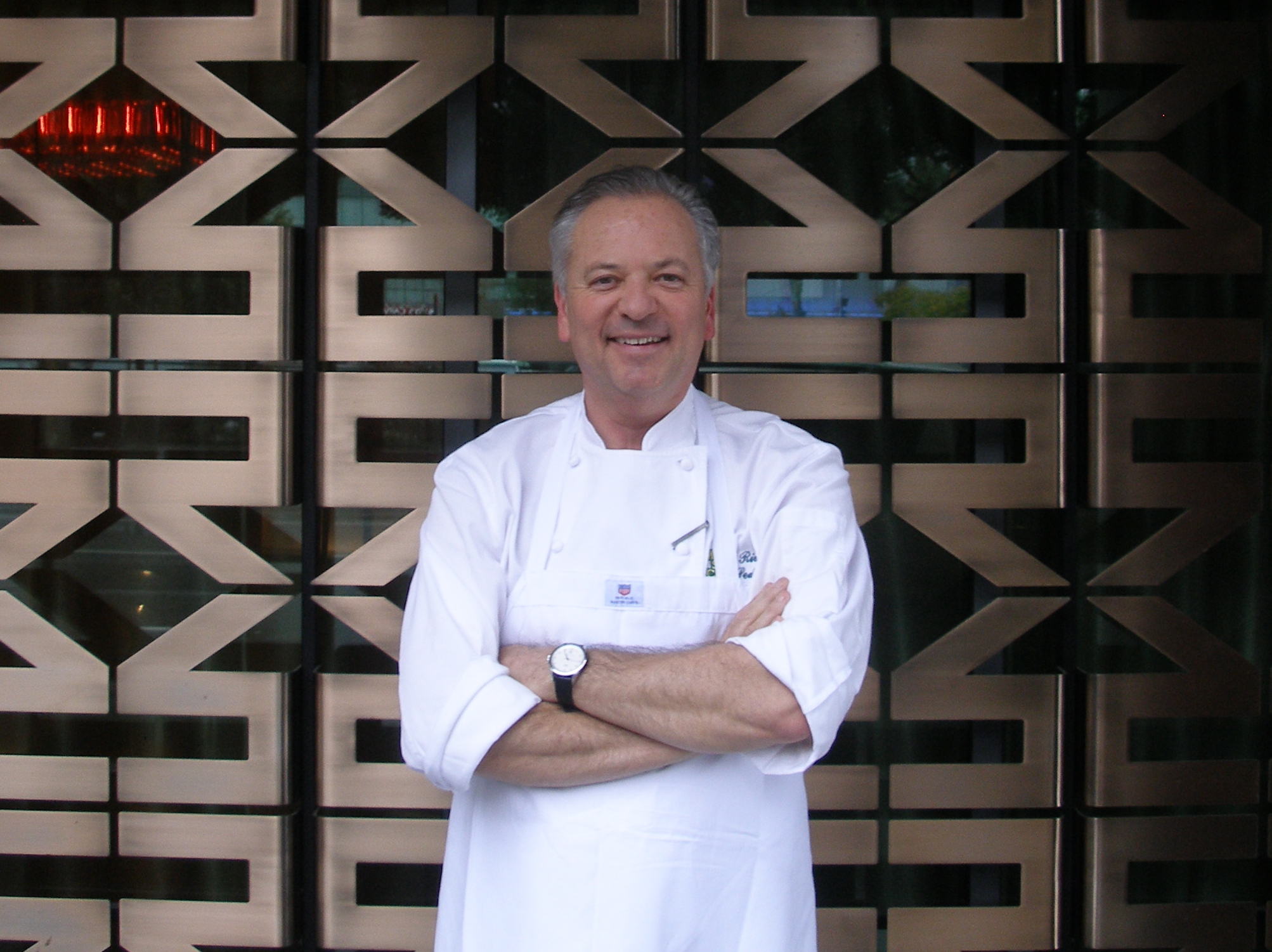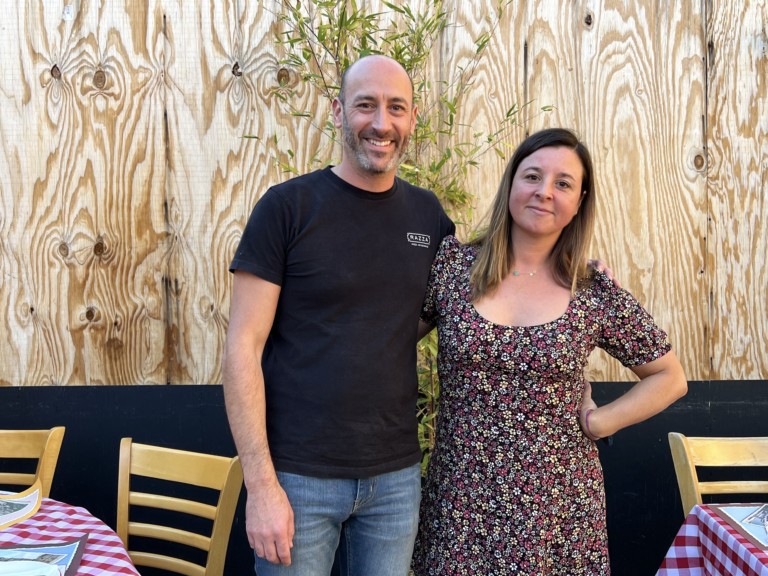“It’s like a river going in and out of Spain, Portugal, South America, regional Mexico and the Caribbean. They’re all sort of woven together geographically, but they’re also drawn together chronologically.” Chef John Rivera Sedlar reflects on his menu at Rivera, the new downtown L.A. restaurant he opened today with partners Bill Chait and Eddie Sotto. “Our food mandate and philosophy is really to explore ancient foods, traditional foods, contemporary foods and futuristic foods.” Sedlar’s been building toward this pan-Latin restaurant his entire life, and he finally plans to deliver “the past and the future on one plate.”
“I’ve always cooked in a Latin idiom, starting with Southwest,” says Sedlar, who grew up in Santa Fe, New Mexico. As a child, he spent a lot of time in the pueblo of Abiquiu, at his family’s ranch. He’d play on dirt floors while his family would cook bizcochitos and empanaditas in the wood-burning oven while snow fell outside. His grandmother was a professional cook and burned piñon, and Sedlar distinctly remembers the crackle and smell of the wood.
His first job was at The Bull Ring, a fine-dining French restaurant on old Santa Fe Trail. At lunch and dinner, he perfected veal Viennoise, lobster Newburgh and trout Almondine, “which was very, very contemporary at that time…One side of the menu was traditional French dishes, classic French haute cuisine, and on the other side of the menu were New Mexico classics. Enchiladas, tacos, tamales, and you could choose either, or, but the foods weren’t mixed.” Sedlar saw no need for segregation and decided to combine “intricate culinary techniques” with “delicious indigenous ingredients from the Southwest.”
“Because I’m half Latino, I wanted to put tortillas in fine-dining restaurants and it was frowned upon,” says Sedlar. He made a concerted effort to educate people and elevate the cuisine, “partially through nutrition.” He decided to pare down frying and cheese and “the flavors really came through.”
Equipped with his gastronomic vision, Sedlar moved to California. He was in his early 20’s but became executive chef at a tiny Manhattan Beach restaurant called The Silo and almost immediately attracted critics’ attention. At this stage, Sedlar wasn’t certain whether he’d remain a chef or move onto something else, possibly architecture. “I started enjoying it and decided that I should either get really, really good at it or get out of the business,” says Sedlar. “I challenged myself to learn more complex techniques and philosophies about food and to study what’s going on in different areas of the world, and the history of food.”
After The Silo, Sedlar found a mentor in Jean Bertranou from L’Ermitage. “He was very visionary,” says Sedlar. “He started a small duck farm, smuggled in fertile duck eggs. He liked the flavor of those ducks and the size of their breasts. He brought in live fish. He had an aquarium in his restaurant. He brought in French seeds to grow the freshest green beans by farmers. He [even] changed his china with the seasons…He was just terrific, a good inspiration.”
Bertranou died of a brain tumor in 1983, and Sedlar left to open his own restaurant in Santa Monica – Abiquiu – named for the pueblo of his youth. “It was really a landmark restaurant,” says Sedlar, “to introduce a lot of spicy chilies and masa products into a fine dining environment.”
Sedlar was a spokesperson for Patrón tequila for 10 years. “[Seagram’s] asked me if I would help educate people about tequila. For 10 years we went around the country…We took groups to Mexico, really immersed ourselves in tequila, through a program called Experiencing Tequila. It was the most comprehensive tequila program that will ever be put together.”
At Rivera, Sedlar, Chait and Sotto decided to “leave behind haute French cuisine with cream and butter,” opting for concentrated blasts of “cleaner, crisper flavors.” Rivera is also designed to educate diners about Latin food, which until recently was “perceived as a second class cuisine.” Not at Rivera, where he “combines ancient types of cooking with the new molecular gastronomy, with foams, gels and spherification.”
Since Seagram’s doesn’t exist anymore, Rivera inherits Sedlar’s groundbreaking tequila program. “I infuse tequilas with certain fruits and vegetables and spices and seasonings,” says Sedlar. “And you can have a flight of seasonal tequilas. We have our summer collection, our winter, our fall and our spring.” For the winter collection, you’ll find blancos with cucumber, blancos with rosemary, blancos with sage, reposado with vanilla, reposado with café, añejo with dulce de leche, and a Bordeaux añejo combination.
Rivera is Sedlar’s work, but in his spare time, he’s a culinary historian. As soon as Sedlar secures a downtown location, he plans to open Museum Tamal, a food museum that views the Latin American world through a culinary prism. Why tamal? [Throughout Latin countries] it’s a dish that’s held in very high reverence,” says Sedlar. “It’s served on all special family occasions. People really have a lot of ritual around tamales. They make them together, days at a time, they eat them together, they give them as gifts. They’re little gifts wrapped in corn husks.”
Museum Tamal will house a casual café and a “fine dining homage to all Latin food…you can go to the culinary exhibitions that talk about food and processes and history. Then you go the restaurants and eat some of those dishes. Including chocolate, corn, chocolate, chilies.”
To continue his culinary education, Sedlar travels frequently throughout the Latin world, including Barcelona. In a year or more, after Rivera is running strong, he plans to visit Bolivia and Ecuador, for the seafood, and the Galagapos, before it’s completely overrun by tourists.
ADVERTISEMENT
Click here for great deals on Neil Diamond Los Angeles Tickets and Angels Tickets.









Blog Comments
Bloggers We Love: FoodGPS' Joshua Lurie Talks Food, Drink & LA's Infinite Possibilities | outside.in blog
August 4, 2010 at 10:28 AM
[…] profiles are really interesting. Who have been some of your favorites? “John Rivera Sedlar – the Chef/Owner of Rivera in Downtown LA. I didn’t really know much about his history before […]
barbara seagram
March 17, 2010 at 2:56 PM
[…] buildings of this comples is in the area of Aghia varvara (Santa Barbara) in Paliaon Psychikon. …Food GPS Profile: Rivera Chef John Rivera Sedlar[ Seagram’s] asked me if I would help educate people about tequila. For 10 years we went … Since […]
Scott
December 9, 2009 at 5:59 PM
While a Junior in Redondo Union H.S., I worked in the kitchen of the Silo Restaurant in Manhattan Beach. I rode my bike there and worked directly under Mr. Sedlar and his second in command Paul, until the restaurant closed just prior to August 1979. I distinctly remember that Mr. Sedlar wanted someone to work in the kitchen who had “No Bad Habits”. I felt quite honored that I didn’t wash dishes or clean the kitchen at the end of the night… I did exactly what they did, and knew even then, that I was very fortunate to have the experience of working under two accomplished Chefs at the age of 17,. I learned only what they taught me, and did everything exactly the way they wanted it done, until I could prepare any meal on the menu from start to finish! Having me as an assistant gave each of them the opportunity to have a day off! Every aspect of working in a kitchen, I learned from Mr. Sedlar: knife skills, kitchen etiquette, food & sauce preparation, presentation, etc. For me it was a fortuitous and memorable experience that will always stay with me. It was nice to see this article and bring it all to the surface again!
Joshua Lurie
December 9, 2009 at 11:26 PM
Scott, thanks for sharing that story.
MM Morris
November 3, 2009 at 3:43 PM
I worked with Mr. Sedlar at his restaurnat St. Estephe in Manhattan Beach, CA and am surprised that it’s not mentioned in this article. It was wildly popular back in the early 80’s.
Joshua Lurie
November 3, 2009 at 3:55 PM
Chef Sedlar didn’t mention St. Estephe during our interview, but afterwards, the restaurant’s significance came to my attention. Thanks for adding that stage of his career to the story.
Eric Rosen
February 19, 2009 at 2:42 PM
Great profile, Josh! I’m going there for dinner tonight, can’t wait to compare notes…
Joshua Lurie
February 19, 2009 at 4:27 PM
Thanks. Let me know what you think.